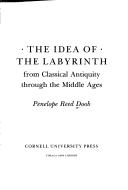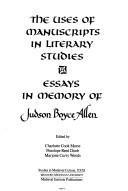| Listing 1 - 5 of 5 |
Sort by
|
Book
ISBN: 0801480000 1501738453 1501738461 Year: 1992 Publisher: Ithaca and London : Cornell University Press,
Abstract | Keywords | Export | Availability | Bookmark
 Loading...
Loading...Choose an application
- Reference Manager
- EndNote
- RefWorks (Direct export to RefWorks)
Ancient and medieval labyrinths embody paradox, according to Penelope Reed Doob. Their structure allows a double perspective-the baffling, fragmented prospect confronting the maze-treader within, and the comprehensive vision available to those without. Mazes simultaneously assert order and chaos, artistry and confusion, articulated clarity and bewildering complexity, perfected pattern and hesitant process. In this handsomely illustrated book, Doob reconstructs from a variety of literary and visual sources the idea of the labyrinth from the classical period through the Middle Ages.Doob first examines several complementary traditions of the maze topos, showing how ancient historical and geographical writings generate metaphors in which the labyrinth signifies admirable complexity, while poetic texts tend to suggest that the labyrinth is a sign of moral duplicity. She then describes two common models of the labyrinth and explores their formal implications: the unicursal model, with no false turnings, found almost universally in the visual arts; and the multicursal model, with blind alleys and dead ends, characteristic of literary texts. This paradigmatic clash between the labyrinths of art and of literature becomes a key to the metaphorical potential of the maze, as Doob's examination of a vast array of materials from the classical period through the Middle Ages suggests. She concludes with linked readings of four "labyrinths of words": Virgil's Aeneid, Boethius' Consolation of Philosophy, Dante's Divine Comedy, and Chaucer's House of Fame, each of which plays with and transforms received ideas of the labyrinth as well as reflecting and responding to aspects of the texts that influenced it.Doob not only provides fresh theoretical and historical perspectives on the labyrinth tradition, but also portrays a complex medieval aesthetic that helps us to approach structurally elaborate early works. Readers in such fields as Classical literature, Medieval Studies, Renaissance Studies, comparative literature, literary theory, art history, and intellectual history will welcome this wide-ranging and illuminating book.
Comparative literature --- anno 500-1499 --- Antiquity --- Classical literature --- Labyrinths in art --- Labyrinths in literature --- Literature, Medieval --- Littérature ancienne --- Labyrinthes dans l'art --- Labyrinthes dans la littérature --- Littérature médiévale --- History and criticism --- Histoire et critique --- Littérature ancienne --- Labyrinthes dans la littérature --- Littérature médiévale --- Labyrinths in art. --- Labyrinths in literature. --- History and criticism.

ISBN: 0801423937 1501738461 0801480000 1501738453 Year: 1990 Publisher: Ithaca (N.Y.) : Cornell university press,
Abstract | Keywords | Export | Availability | Bookmark
 Loading...
Loading...Choose an application
- Reference Manager
- EndNote
- RefWorks (Direct export to RefWorks)
Ancient and medieval labyrinths embody paradox, according to Penelope Reed Doob. Their structure allows a double perspective-the baffling, fragmented prospect confronting the maze-treader within, and the comprehensive vision available to those without. Mazes simultaneously assert order and chaos, artistry and confusion, articulated clarity and bewildering complexity, perfected pattern and hesitant process. In this handsomely illustrated book, Doob reconstructs from a variety of literary and visual sources the idea of the labyrinth from the classical period through the Middle Ages.Doob first examines several complementary traditions of the maze topos, showing how ancient historical and geographical writings generate metaphors in which the labyrinth signifies admirable complexity, while poetic texts tend to suggest that the labyrinth is a sign of moral duplicity. She then describes two common models of the labyrinth and explores their formal implications: the unicursal model, with no false turnings, found almost universally in the visual arts; and the multicursal model, with blind alleys and dead ends, characteristic of literary texts. This paradigmatic clash between the labyrinths of art and of literature becomes a key to the metaphorical potential of the maze, as Doob's examination of a vast array of materials from the classical period through the Middle Ages suggests. She concludes with linked readings of four "labyrinths of words": Virgil's Aeneid, Boethius' Consolation of Philosophy, Dante's Divine Comedy, and Chaucer's House of Fame, each of which plays with and transforms received ideas of the labyrinth as well as reflecting and responding to aspects of the texts that influenced it.Doob not only provides fresh theoretical and historical perspectives on the labyrinth tradition, but also portrays a complex medieval aesthetic that helps us to approach structurally elaborate early works. Readers in such fields as Classical literature, Medieval Studies, Renaissance Studies, comparative literature, literary theory, art history, and intellectual history will welcome this wide-ranging and illuminating book.
Doolhoven in de literatuur --- Labyrinten in de literatuur --- Labyrinthes dans la littérature --- Labyrinths in literature --- Classical literature --- -Labyrinths in art --- Literature, Medieval --- -European literature --- Medieval literature --- Literature, Classical --- Literature --- Literature, Ancient --- Greek literature --- Latin literature --- History and criticism --- Labyrinths in art. --- Labyrinths in literature. --- History and criticism. --- -History and criticism --- Labyrinths in art --- Literature [Medieval ]
Book
ISBN: 150173847X Year: 2019 Publisher: Cornell University Press
Abstract | Keywords | Export | Availability | Bookmark
 Loading...
Loading...Choose an application
- Reference Manager
- EndNote
- RefWorks (Direct export to RefWorks)
Ancient and medieval labyrinths embody paradox, according to Penelope Reed Doob. Their structure allows a double perspective—the baffling, fragmented prospect confronting the maze-treader within, and the comprehensive vision available to those without. Mazes simultaneously assert order and chaos, artistry and confusion, articulated clarity and bewildering complexity, perfected pattern and hesitant process. In this handsomely illustrated book, Doob reconstructs from a variety of literary and visual sources the idea of the labyrinth from the classical period through the Middle Ages.Doob first examines several complementary traditions of the maze topos, showing how ancient historical and geographical writings generate metaphors in which the labyrinth signifies admirable complexity, while poetic texts tend to suggest that the labyrinth is a sign of moral duplicity. She then describes two common models of the labyrinth and explores their formal implications: the unicursal model, with no false turnings, found almost universally in the visual arts; and the multicursal model, with blind alleys and dead ends, characteristic of literary texts. This paradigmatic clash between the labyrinths of art and of literature becomes a key to the metaphorical potential of the maze, as Doob's examination of a vast array of materials from the classical period through the Middle Ages suggests. She concludes with linked readings of four "labyrinths of words": Virgil's Aeneid, Boethius' Consolation of Philosophy, Dante's Divine Comedy, and Chaucer's House of Fame, each of which plays with and transforms received ideas of the labyrinth as well as reflecting and responding to aspects of the texts that influenced it.Doob not only provides fresh theoretical and historical perspectives on the labyrinth tradition, but also portrays a complex medieval aesthetic that helps us to approach structurally elaborate early works. Readers in such fields as Classical literature, Medieval Studies, Renaissance Studies, comparative literature, literary theory, art history, and intellectual history will welcome this wide-ranging and illuminating book.Ancient and medieval labyrinths embody paradox, according to Penelope Reed Doob. Their structure allows a double perspective—the baffling, fragmented prospect confronting the maze-treader within, and the comprehensive vision available to those without. Mazes simultaneously assert order and chaos, artistry and confusion, articulated clarity and bewildering complexity, perfected pattern and hesitant process. In this handsomely illustrated book, Doob reconstructs from a variety of literary and visual sources the idea of the labyrinth from the classical period through the Middle Ages.Doob first examines several complementary traditions of the maze topos, showing how ancient historical and geographical writings generate metaphors in which the labyrinth signifies admirable complexity, while poetic texts tend to suggest that the labyrinth is a sign of moral duplicity. She then describes two common models of the labyrinth and explores their formal implications: the unicursal model, with no false turnings, found almost universally in the visual arts; and the multicursal model, with blind alleys and dead ends, characteristic of literary texts. This paradigmatic clash between the labyrinths of art and of literature becomes a key to the metaphorical potential of the maze, as Doob's examination of a vast array of materials from the classical period through the Middle Ages suggests. She concludes with linked readings of four "labyrinths of words": Virgil's Aeneid, Boethius' Consolation of Philosophy, Dante's Divine Comedy, and Chaucer's House of Fame, each of which plays with and transforms received ideas of the labyrinth as well as reflecting and responding to aspects of the texts that influenced it.Doob not only provides fresh theoretical and historical perspectives on the labyrinth tradition, but also portrays a complex medieval aesthetic that helps us to approach structurally elaborate early works. Readers in such fields as Classical literature, Medieval Studies, Renaissance Studies, comparative literature, literary theory, art history, and intellectual history will welcome this wide-ranging and illuminating book.
Book
ISBN: 9780300016758 0300016751 0369916751 9780369916754 Year: 1974 Publisher: New Haven : Yale Univ. Press,
Abstract | Keywords | Export | Availability | Bookmark
 Loading...
Loading...Choose an application
- Reference Manager
- EndNote
- RefWorks (Direct export to RefWorks)
The author focuses attention on what seem to be the two most important problems for a study of the literary uses of madness in Middle English literature: 1)What does madness generally mean in medieval society and literature, and 2)How do medieval attitudes affect the literary uses and meanings of madness? The author shows only ways of looking at madness that were available in late medieval England.
English literature --- Medicine in Literature. --- Mental Disorders. --- Mental illness in literature. --- History and criticism --- Middle English. --- 1100-1500.

ISBN: 1879288133 1879288141 Year: 1992 Volume: vol 31
Abstract | Keywords | Export | Availability | Bookmark
 Loading...
Loading...Choose an application
- Reference Manager
- EndNote
- RefWorks (Direct export to RefWorks)
Manuscripts. Epigraphy. Paleography --- Old English literature --- English manuscripts (Middle) --- Handschriften [Engelse ] (Middel) --- Handschriften [Middeleeuwse ] --- Literary transmission --- Manuscript transmission --- Manuscripts [English ] (Middle) --- Manuscripts [Medieval ] --- Manuscripts [Middle English ] --- Manuscrits anglais (Moyen) --- Manuscrits médiévaux --- Manuscrits--Transmission --- Medieval manuscripts --- Middeleeuwse handschriften --- Middle English manuscripts --- Tekstoverlevering --- Textual transmission --- Transmission de textes --- Transmission des manuscrits --- Transmission des textes --- Transmission littéraire --- Transmission of texts --- 091:82 --- 091 =20 --- 820 "04/14" --- English literature --- -Literature, Medieval --- -Manuscripts, English (Middle) --- Manuscripts, Medieval --- Criticism, Textual --- Editions --- Manuscripts --- Manuscripts, Middle English --- European literature --- Medieval literature --- British literature --- Inklings (Group of writers) --- Nonsense Club (Group of writers) --- Order of the Fancy (Group of writers) --- Handschriftenkunde. Handschriftencatalogi-:-Literatuur. Algemene literatuurwetenschap --- Handschriftenkunde. Handschriftencatalogi--Engels --- Engelse literatuur--Middeleeuwen --- 820 "04/14" Engelse literatuur--Middeleeuwen --- 091 =20 Handschriftenkunde. Handschriftencatalogi--Engels --- 091:82 Handschriftenkunde. Handschriftencatalogi-:-Literatuur. Algemene literatuurwetenschap --- Literature, Medieval --- Manuscripts, English (Middle) --- Literature [Medieval ] --- Criticism [Textual ] --- Middle English, 1100-1500 --- Literature, Medieval - Criticism, Textual. --- English literature - Middle English, 1100-1500 - Criticism, Textual. --- Manuscripts, Medieval. --- Transmission of texts.
| Listing 1 - 5 of 5 |
Sort by
|

 Search
Search Feedback
Feedback About UniCat
About UniCat  Help
Help News
News